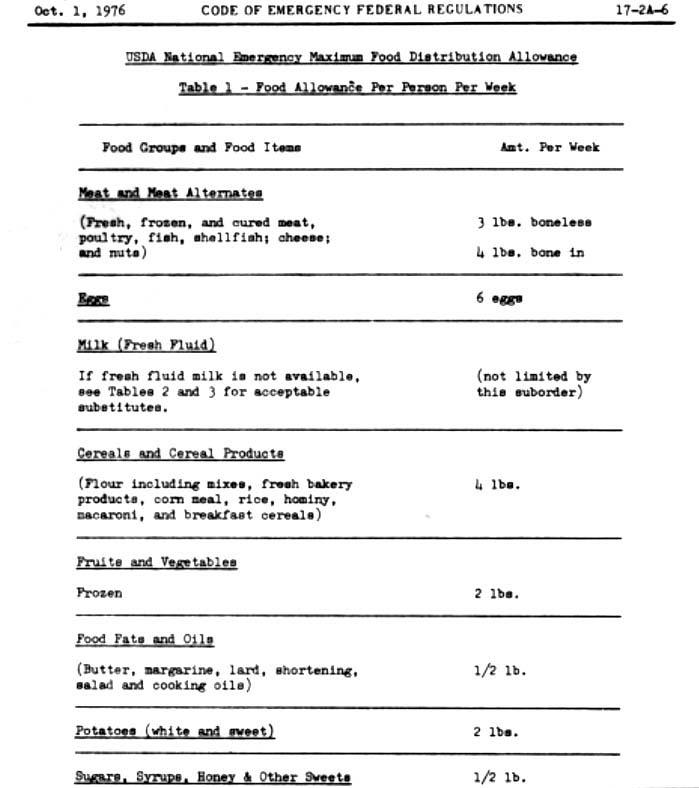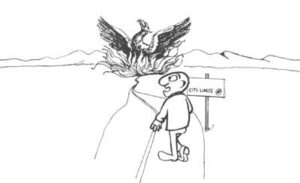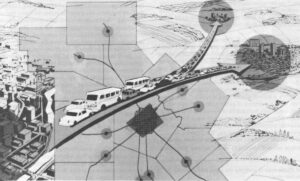WASHINGTON, D.C.–Starting a few days after a nuclear attack on the United States, all surviving Americans will be allowed to buy three pounds of meat or meat alternates a week. If there’s a bone in the meat, the weekly quota will be four pounds. Meat alternates consist of poultry, fish, shellfish, cheese and nuts. Twelve eggs or two-and-three-quarters pounds of potatoes may be substituted for each pound of (boneless) meat. All of this is spelled out in Defense Food Order Number 2, which has been prepared by the Department Of Agriculture and readied for publication in the Emergency Federal Register. The Emergency Federal Register will be published by the General Services Administration, replacing the regular Federal Register, following a nuclear attack.
Planning for life after a nuclear war has been going on throughout the federal government for at least two decades. The National Plan for Emergency Preparedness, published in 1964, is an unclassified compendium of emergency measures “not only for the defeat of the enemy but also for the survival and eventual recovery of the United States.” A draft version of the National Plan for Civil Emergency Management, which is now being written to replace the 1964 document, acknowledges that nuclear war “would wreck a major portion of the economy and cause casualties and deaths measured in tens of millions. It would strain the bonds which hold the social and political structure together, perhaps to the breaking point. But it would leave survivors.” There would, to be precise, be about 93 million survivors (32 million of whom would be suffering from injuries, burns, or radiation sickness) immediately following a full-scale nuclear attack in the near future, according to a recent Federal Emergency Management study. It is to those survivors and to the preservation of those social and political bonds between them that federal emergency preparedness planning is dedicated.

“The subject is full of gloom and doom,” says Paul Krueger, the official who oversees resource management for the Federal Emergency Management Agency, which coordinates federal preparedness planning. “Most people hope someone is taking care of these things but don’t want to know the details.”
In fact, many people are taking care of these things, and the plans they have produced are crammed with thousands of details. Executive Order 11490, issued by Richard Nixon in 1969 and amended several times since, assigns emergency planning responsibilities to 32 federal departments and agencies, ranging from the Department of State, which is charged with making plans for executing “political strategy toward hostile or enemy States,” to the Railroad Retirement Board, which is to make plans for administering the Railroad Retirement Act “consistent with overall Federal plans for continuation of benefit payments after an enemy attack.”
An overview of post-nuclear war priorities is given by a 1980 Presidential order which lists “the basic essentials necessary for maintaining a viable economy during the first six months following an attack.” The list includes insulin, yellow fever vaccine, diapers, sleeping bags, circuit breakers, coal, bulldozers, radiation detectors, and about 200 other items. The production and distribution of these items are to be given top priority, along with military operations and the maintenance-” or reestablishment” -of government authority and control.
To preserve a governmental structure after a nuclear attack, plans are in place to evacuate small cadres of bureaucrats to rural shelters if nuclear war ever appears imminent. Survivors in those departments would take charge of essential matters in their customary areas of responsibility and petition other departments for necessary support. Thus the Department of Housing and Urban Development would allocate supplies of housing materials and would petition the Department of Transportation for trucks to deliver the materials where they were needed. An Office of Defense Resources would be created to establish national priorities and resolve conflicting needs.
Vulnerability Factors
Standby authority for emergency organizations and policies is contained in a set of classified documents known collectively as Federal Emergency Plan D, which would be issued by the President as needed after a nuclear attack. If Congress was still functioning, Plan D would not be used; instead, similar documents would be submitted for legislative action. These are known as “Other Than D” documents and are also classified.
To determine which resources had survived the war, the government has established a computerized system, now operated by the Federal Emergency Management Agency. During the last 20 years, federal agencies have poured information into a computer data base that now includes facts about well over one million American “resources.” Resources include factories, military installations, petroleum storage depots, ports, locks, dams, radio stations, welfare offices, food warehouses and farms. Population data is fed into the system by the Census Bureau.
“We prefer to get the data by latitude and longitude,” said William Fehlberg, who presides over the system from an underground office in Olney, Maryland. “If we’re not given the latitude and longitude, we have the coordinates of every ZIP code, so we use them.” Each resource is also assigned a “vulnerability factor,” based on its type of construction.
“Our damage estimation programs,” Fehlberg explained, “work on the principle that you calculate the distance between weapon detonations and resources. You calculate the overpressures [created by the blasts] and compare them with the vulnerability factors. You end up with a probability that a particular resource, or type of resource, has been destroyed.
“The program also has a fallout model,” Fehlberg said, “to calculate long-term fatalities and determine how long facilities will be off-limits.” Every day, the National Oceanic and Atmospheric Administration feeds wind and weather data into the FEMA computer so it will have some basis for predicting fallout patterns if that day sees the start of World War III. But Fehlberg acknowledges that the system is not sure to work. “How often,” he asks, “is the weatherman right?”
Another limitation on the performance of the system after a nuclear attack would be the accuracy of the information on “NUDETS”-nuclear detonations-that is fed into it. The prime source of information on where weapons have landed, or are headed, is slated to be the North American Air Defense Command in Colorado. “They don’t give you the coordinates,” Fehlberg said. “They give you the number of a ten mile circle the weapon has landed in. We know what targets are in the circle, so we can make assumptions as to weapon size, its exact coordinates, and whether it’s air-burst or ground-burst.” The computer digests those assumptions and then, in response to queries from surviving federal officials with access to computer terminals, makes estimates of the situation. A manual for using the computer offers the following sample query:
“WHICH OCEAN PORTS REGION 1 OPERABLE WITH NO FIRE”
Nobody can say for sure whether the computer will really know how many ocean ports in region one are operable and not in flames after a nuclear attack. “We’ve never had a war to calibrate the programs,” Fehlberg notes. But the entire system is tried out in government-wide drills once or twice a year.
“Early last year we had an exercise where the enemy aimed at our hard military targets, ” said Harold Gay, an emergency planner in the Department of Agriculture who is a veteran of many exercises. “We applied the computerized damage assessment to food facilities and found out what food we had. We also knew what surviving population we had. To move the food to the people, we applied to the Department of Transportation. They knew the damage to highways. Sometimes the Department of Energy wants to give more fuel to defense than food. So we do some horse-trading. If we can’t resolve things, then ODR [Office of Defense Resources] has to make a decision.”

Under Defense Food Order Number 2, every food processor, wholesaler and warehouse is required to report its status “within five days after civil defense authorities permit access to [the] facility.” Food is to be delivered to retail outlets only after those outlets have stated in writing how many customers they expect to serve per week. Deliveries are then rationed according to the National Emergency Maximum Food Distribution Allowance (NEMFDA). The weekly (boneless) meat ration is three pounds, so if a grocery store certifies that it expects 1,000 customers, it may receive 3,000 pounds of meat. The administration of rationing at the retail level will be the responsibility of local governments. “You’re going to have some cheaters,” said Harold Gay, “but the concept of the system is feasible. It was developed with industry advisors.”
Besides meat, NEMFDA allows six eggs, four pounds of cereal and cereal products, two pounds of frozen fruits and vegetables, one-half pound of fats and oils, two pounds of potatoes, and one-half pound of sugar per person per week. (Life will be less sweet than it is now, however. All food processors will be required to cut their sugar use by 50 percent.)
“The order provides 2,000 to 2,500 calories per person per day,” said Harold Gay, “about two-thirds of normal caloric input right now, if you could have something from every [food] grouping.” He is not concerned, however, that there won’t be enough food to feed survivors. “Just because you have fallout on a crop doesn’t mean it’s not safe to eat,” he said. “Fallout is dust. It can be removed by normal washing, peeling and so on. If it’s mixed in with the actual food product, then you would store it. Radioactivity decays. Milk, for example, is very susceptible to radioactivity. You can’t hold the milk until the radioactivity decays, but you can process it into cheese and store the cheese.
“A lot would depend on when the attack came. If it was June, you’d have a hell of a loss of yield of the corn crop, because the radioactivity attacks the living organism of the plant. But if it came in August, if you waited until it was safe enough to get out there and run your picker, the dust’d fly off the plants.
“As for live animals, research has shown that they can withstand more radioactivity than humans. If a steer doesn’t show signs of radiation sickness-droopiness, weeping eyes, running bowels, high temperature-the meat is safe to eat.”
Gay’s optimism is supported by a 1977 study conducted by his office in the Agricultural Stabilization and Conservation Service of two imaginary nuclear attacks on the United States. Each attack consisted of 1,160 weapons. One attack, known as “MIKE”, was aimed at military and industrial targets. The second, called “CHARLIE”, was aimed at civilian and industrial targets. The study concluded that, 60 days following the MIKE attack, 57 percent of the pre-attack population would be alive, while 77 percent of food processing facilities would have survived and be accessible. The CHARLIE attack killed more civilians-only 46 percent were alive after 60 days-but almost as many food processing facilities (76 percent) survived and were accessible, so the ratio of food processing facilities to survivors was higher. In addition, in both attacks, relatively more cows, pigs, chickens, turkeys and sheep survived than people.
The study notes, however, that there would be major problems transporting food to areas where it was needed. Disposing of dead animals would be a problem for farmers. And “sugar imports could not be counted on for a while.” No one denies that nuclear war would be a major catastrophe, and that survival and recovery would be difficult and full of uncertainties.
Nevertheless, states the National Plan for Emergency Preparedness, “this much is known: there would be surviving people and resources to be applied to the defense and pursuit of fundamental goals and values. The constructive application of resources to that purpose would depend upon prudent, flexible emergency plans and preparations made now.”
“At least we have a plan,” adds one Agriculture Department executive. “People can say, ‘The goddam plan isn’t going to work.’ But they can’t criticize us for not having one.”
©1981 Ed Zuckerman
Ed Zuckerman, a freelance writer from New York City, has published in Harper’s and Rolling Stone. He is studying the plans and planning for nuclear war.






